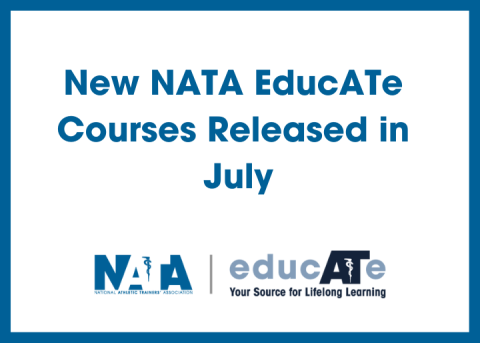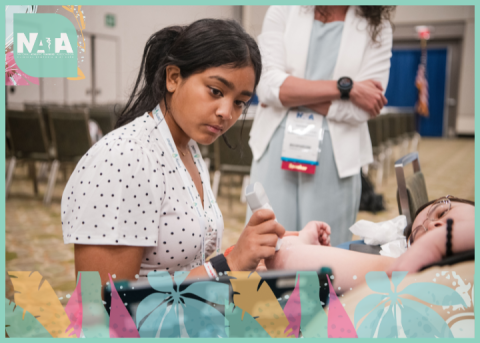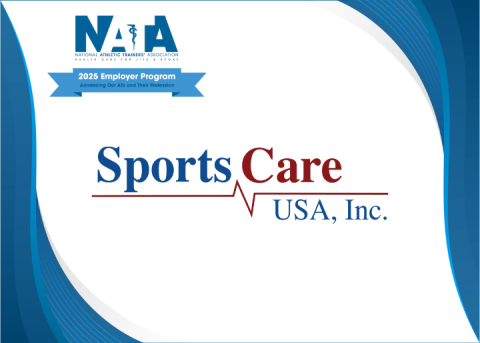
The NATA Hall of Fame is the pinnacle of recognition for members, honoring a select group of athletic trainers who have shaped the athletic training profession and exemplified what it means to live a life of service.
More than a ring, green jacket and plaque on the wall, the NATA Hall of Fame is an honor bestowed on those who have spent countless hours perfecting their skills, mentoring the next generation of ATs and imprinting a lasting impact on the athletic training profession.
The May NATA News featured the class of 2023, highlighting their careers and volunteer achievements, and delves into their journeys as leaders in the profession.
The class of 2023 will be honored and inducted into the NATA Hall of Fame during the 74th NATA Clinical Symposia & AT Expo in Indianapolis.
In this blog, the inductees give insight into their origins in athletic training, sharing why they chose to pursue it as a career.
RICK BURKHOLDER, MS, ATC
I am a former college/university athlete who wanted to stay in sports, but had a science background. Athletic training is in my family, so it was a natural progression following my playing career.
LORIN A. CARTWRIGHT, MS, ATC, CAA
For six years, I played basketball and softball. As a result, my time during the year was always occupied between 2:30 p.m. and 6:30 p.m. In my junior year in college, I was cut from the women’s basketball team. All my roommates played on the basketball team, and I was not sure what to do while they were all gone. I had the opportunity to use the athletic trainer for some injuries and I thought I’d see if I could volunteer my time. I went to see Doug Woods, AT Ret., the Grand Valley State University head athletic trainer. I think he was thinking “Is this what happens when an athlete gets cut?” But he said, “If you can come back after two weeks and can wrap an ankle, you can volunteer.” I spent two weeks wrapping my sister’s ankle with a cloth ankle wrap and my career began in athletic training.
MARK COBERLEY, MS, LAT, ATC
Being from a rural area in the 1980s, I had no idea what an athletic trainer was. I attended a sports camp where someone got up and talked to campers about who an athletic trainer was and explained the role’s responsibilities. I thought that this might be a profession to pursue that fit my interests. It was a profession that combined my interests in sports, medicine and science to help people overcome the setback of injury to perform athletically at the highest levels, and do so specifically within the sporting environment. I was very fortunate to go through a bachelor’s, and then master’s programs, which provided great education and opportunities to prepare me for a successful career and have been in this profession since.
TONY FITZPATRICK, MA, LAT, ATC
My original goal when I went to college was to be a medical doctor. I attended the College of Great Falls (CGF) and was “recruited” to be the “student trainer” for the College of Great Falls Argonauts men’s basketball team after it was discovered I had been a high school “student trainer” for Anaconda High School for four years. It was actually during my time in high school when I first heard of athletic training, and the football coaches sent me to Cramer student camps. While at these Cramer camps, I met AT icons and now NATA Hall of Fame members Naseby Rhinehart and Mark Smahal, AT Ret. That was the first time I had ever heard of athletic training and athletic trainers; I couldn’t believe that this was a career. But my mind was set on being a doctor.
While at CGF, I got involved with Big Brothers Big Sisters and realized that my calling wasn’t necessarily with being a doctor, as the classroom resonated with me. But I still wanted to be involved with medicine somehow. It was Jack Aggers, the University of Wyoming head AT and NATA Hall of Fame member, as well as the father of the CGF men's basketball coach, who had been mentoring me for his son, our head coach (CGF did not have an AT at that time in the early ’80s). Jack taught me so much when he visited. He really encouraged me to explore athletic training, going as far as to try to get me to transfer to Wyoming to be in its AT internship program. But CGF was home. So after I decided to be a teacher, it was Jack who convinced me to explore being a teacher AT, that I could do both and be involved with medicine. After graduating from CGF, it was Jack who introduced me to my OG mentor from Boise State University, Gary Craner, AT Ret., who took me under his wing at Boise State University, got me enrolled in the fairly new AT curriculum program and guided me in being an AT. He saw a need for ATs in high schools then, so he encouraged me to pursue both. These amazing iconic ATs showed me what was possible as an AT; they clearly mastered the science, art and, I would contend, magic of athletic training.
TORY R. LINDLEY, MA, ATC
Perhaps my very first mentor, Jeff Tropf, science teacher at Suttons Bay High School, encouraged me to take a pilot AP Anatomy and Physiology course in 10th grade. His instruction and that class inspired me to pursue a career in health care. The next summer I took a summer sports medicine course taught by my earliest AT mentor, Paul Bragenzer. For me, the profession of athletic training was love at first sight. I over-extended all modern-day licensure regulations in the state of Michigan as a high schooler but thoroughly enjoyed practicing my skills each fall after school with the football team. Blessed with knowledge of ‘what I wanted to be when I grew up’, my college search landed me at Michigan State University with advanced admittance into their AT student program almost two months before my first college class in the fall of 1987.
PAUL A. ULLUCCI JR., PhD, DPT, ATC
Athletic training allowed me to combine my passion for preventing injuries and improving sports performance with the emergent care and rehabilitation of injuries. I love working with highly motivated individuals who are willing to put in the time to improve, and I enjoyed being able to provide the skilled medical care these athletes needed.





